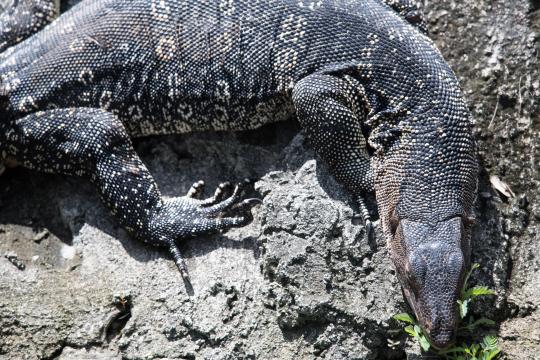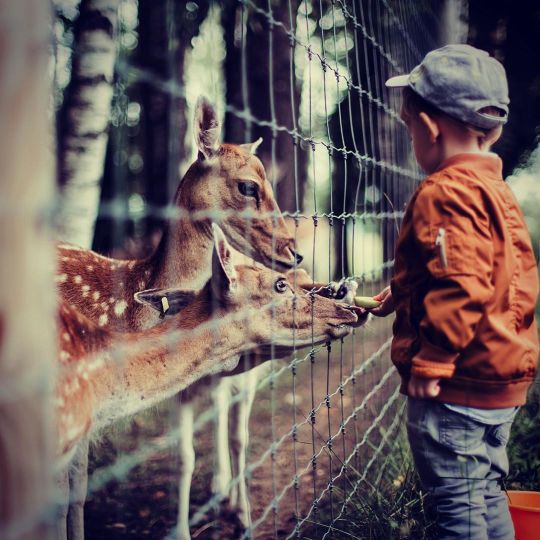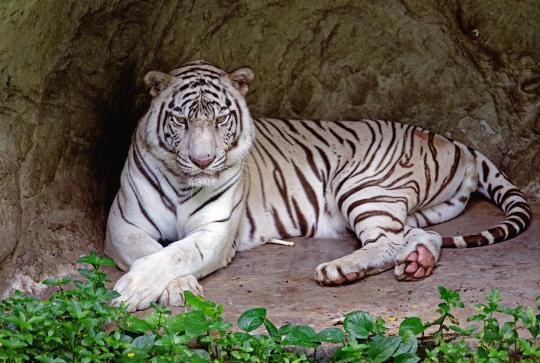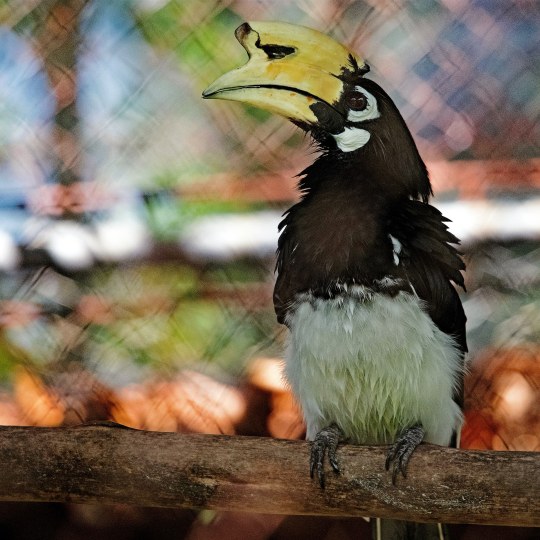#bangkokzoo
Text
Hangin' out with my buddy on a sunny day

Come on, we all have a that friend that really is half dragon and a bit scary, but still nice to hang out with on a hot day.
This couple really did not much out of the day. The Turtle kept his toes in the water, and as I was walking by several times, the large Water Monitor only changed the position of his snout. Something smelly, but not interesting enough to do something else.
Opportunistic and wide spread
The Asian water monitor (Varanus salvator) is a large varanid lizard native to Southeast and South Asia. It is common from the coastal eastern India, Bangladesh and Sri Lanka, Mainland SEA, southern China and Indonesia.
The monitors is highly opportunistic when choosing habitats, and it is semiaquatic. Meaning they are able to live near or in human habitats were there easy access to large water sources. Like Bangkok in Thailand, were I have seen several of theses varanids near the many rivers and channels in that city. Not very large ones, but maybe just under a meter length including their tails.

Moving and smelling the air, crossing the giraffe compound in Dusit Zoo. This one appx 80 cm long.
These animals reach breeding maturity when they are about 40 cm long and a weight of 1 kilo for males, and 50 cm for females. They normally grows up to 2 meter, but there are one specimen in Sri Lanka which reached 3,21 meter. The weight is a moderate appx 20 kg. But the max weight is over 50 kilo.
Their size and weight is second only to the Komodo Dragon lizards.
They are top-level predators, only natural enemies are crocodiles and humans. They eat a huge variation of food, from fish and rodents to human garbage and domesticated cats and dogs. They are not considered a direct danger for humans, but they may bite if cornered. Varanid bites are filled with oral bacterias that can lead to serious infections. And some of the variants may have venom glands.
Edible and skinned
It is an edible animal, hunted and served as a delicious source of protein in several South East Asian cuisines and in India. Globally, their skins are traded in millions for different type of leatherware products. It is not considered threaten. But habitats are threaten by loss and fragmentation.

No idea of a possible future as shoes and handbags.
The Red eared slider Terrapin turtle are not native to South East Asia at all, it origins in North America in Southeast around Mississippi and Gulf of Mexico. It is consider one of the worst invasive species in the world, being spread as a pet release or escapees. They are spread all over the Eurasian continent, from Scotland and Russia to South east Asia, the Pacific and Zealandia.
#bangkokzoo#lostplaces#thaifood#turtle#asiancuisine#2014#Asian#water#monitor#varanus#salvator#2014CE#bangkok#thailand#lastchancetosee#dusit#zoo#dusitzoo#animalphotography#citylife#citywalk#art#market#buddhism#bluesky
4 notes
·
View notes
Photo

WORLD MOST VISITED PLACE BANGKOK In this articles we are going to explore one of the best tourist places in “Bangkok”, which is the capital of Thailand and also known as “Krung Thep”. You will be shocked to know that it is the most visited place in the world and welcomes more visitors than any other city in the world. In Bangkok, nights are never dark, and the streets are full of people. #hotelsataverylowprice #Bangkok #besttimetovisit #chatuchakmarket #chinatown #grandpalace #khosanroad #madametussauds #oceanworld #reclingbuddha #bangkokzoo #riverchonpark #skybars #tatoos #thaimassage #watarun #lumphinipark #yaowaratroad #mbkcenter #infogalaxie (at Bangkok, Thailand) https://www.instagram.com/p/CDYIYxWpEnP/?igshid=1xujhmtxi4811
#hotelsataverylowprice#bangkok#besttimetovisit#chatuchakmarket#chinatown#grandpalace#khosanroad#madametussauds#oceanworld#reclingbuddha#bangkokzoo#riverchonpark#skybars#tatoos#thaimassage#watarun#lumphinipark#yaowaratroad#mbkcenter#infogalaxie
1 note
·
View note
Photo

Made some really cool, new friends. Best part of traveling is meeting really cool people. Or non people in this case. . . . ✔️Like this? ☝️ Follow me for #instadaily ✔️Feel free to repost it 🔁 ✔️Tag someone who could use this. 👇 🔻Love your Comments below🔻 . . . #myworld #lovingit #newfriends #gratitude #happy #inspiration #yolo #hotweather #amazing #life #beautiful #vacation #Thailand #newfriends #like #happydays #BangkokZoo #climatechange #future #goals #biggoals #follow #me #futureisbright #change #carpediem #mindset #motivational #love https://www.instagram.com/p/BvTqhNCnRPJ/?utm_source=ig_tumblr_share&igshid=1j6dqnswgatsx
#instadaily#myworld#lovingit#newfriends#gratitude#happy#inspiration#yolo#hotweather#amazing#life#beautiful#vacation#thailand#like#happydays#bangkokzoo#climatechange#future#goals#biggoals#follow#me#futureisbright#change#carpediem#mindset#motivational#love
0 notes
Photo

🐪🍃 สูงมากกกกกกก 😍 . #giraffe #giraffes #dusitzoo #zoo #bangkokzoo #dusitzoobangkok #twogiraffes #justthetwoofus #thelovers #animallover #animallovers #zoolovers #zoolover #bkk #bangkok #thailand #longneck #longnecks #cutie #cuteness #cutest #cutiepie #ilovethem #mademesmile #vsco #vscocam #yesterday #beautifulcreatures #beautifulcreature (at สวนสัตว์ดุสิต Dusit Zoo)
#vsco#zoolover#yesterday#thailand#animallovers#cutie#bangkok#longneck#longnecks#bangkokzoo#zoo#cutest#zoolovers#dusitzoo#giraffe#beautifulcreatures#animallover#cuteness#dusitzoobangkok#mademesmile#vscocam#twogiraffes#thelovers#giraffes#justthetwoofus#cutiepie#bkk#beautifulcreature#ilovethem
0 notes
Link
Read my latest blogpost from my Thailand Travel Blog...
1 note
·
View note
Text
Considering the veggie option

I find myself doing this more and more frequently. A smart and easy way for health and environment to improve is to increase the amount of vegetables and fruits in the daily diet.
The Black-crowned/Black-capped Night Heron (Nycticorax nycticorax) is a medium sized heron, a bit more stocky design than other herons and egrets. It is found in most of the world, except from the coldest areas and in Zealandia and Australia. It prefer fresh and salt-water wetlands.
They feed on small fish, insects, small mammals and birds, frogs and crustaceans. Night herons are among the herons using tools, they use bait to lure prey into striking distance.
Flexible approach
The adult birds are appx 65 cm long, and weighs in around 800 gram. The male version is normally slightly larger than the female, but otherwise they look similar.
In resting pose, they look huddled and hunched. But this fellow, looking for food, has its neck stretched as they do when hunting. Their plumage is white/grey on adult, while younger specimens have a more brown colouring.
Photos of the bird from different areas looks like the night heron is a bird dressed for the occasions, with slight variations in colours.
#bangkokzoo#lostforever#dinner#vegan#vegetarian#flexitarian#2018#heron#egret#birdphotography#2018CE#bangkok#thailand#lastchancetosee#dusit#zoo#dusitzoo#animalphotography#citylife#citywalk#art#buddhism#bluesky#Black-crowned#Black-capped#Night#Heron#Nycticorax
3 notes
·
View notes
Text
Eye of the tiger

Honestly, it is a cliché, a popular phrase. A bit of a sarcastic joke.
Until a tiger actually eyes you. And flexes their teeth in this nonchalant way any cat does when they are being cute and intimidating.
Have I mentioned that #ilovecats?
You feel eyed up as a potential dinner. And sure enjoying the physical distance between you and the big animal.
And, in this instance, the thick glass and iron fence.
Good life as captives
Dusit Zoo had several large cats and versions of tigers in captivity. In 2014 there were Bengal Tigers like this fellow, and white versions of the same species. There were some Indonesian tigers too, but they were moved to Ubon Zoo outside Bangkok sometime before 2017.
The conditions for the tigers and the animals in general in Dusit Zoo was considered good, according to the "For Tigers"-association. They do regular inspections of tigers in captivity.
The tiger enclosures was each comprised of an outside spacious area and also a hidden den or night room at the back end of the enclosure.
The animals had a pond or a moat for bathing all filled plentifully. It was plentiful of grass and natural vegetation. The big cats had natural enrichment, scratching posts and pulley systems for food enrichment. Facilities had caves and some platformed areas to climb.

Health conditions of the animals was observed as good. No overcrowding, good body conditions and none visible injuries. By way of mental health, there was none observation of nervous, dissatisfied pacing. The cats performed in natural positive behaviours such as scent marking, sniffing, patrolling territory, sleeping and eating were all observed. Tigers appeared relaxed and at ease with surroundings, as its stated in the report, based on three inspections over five years until Dusit Zoo was closed down.
#catlover#2014CE#citylife#citywalk#bluesky#art#bangkok#thailand#lastchancetosee#dusit#zoo#dusitzoo#bangkokzoo#lostforever#2014#tiger#Panthera#tigris#eyeofthetiger#hunger#food#dinnerdate
3 notes
·
View notes
Text
A blonde moment for a white lion

White lions are rare and highly appreciated, often considered divine and royal.
And sometimes you caught them strike a pose like a blonde diva.
These White Lion (Panthera leo) are not albinos, they are a rare mutation of colour in lions. And it only occurs in one area of the world: In the Kruger-to-canyons Biosphere in Southern Africa. The otherwise tawny prides here carry the gene, and even if the cubs are caught or killed, there are still white lions being born.
Careless care
Unfortunately, lions in South Africa are no longer considered threatened, meaning the trade in everything lion-related has increased. From trophy hunting to bone-trading for "medicinal" purposes.
This includes trading with white lions, even though they are pretty rare. For a time, they went extinct in the wild, but were reintroduced in the hunter free Kruger National Park in 2014.

In Thailand after the closure of Bangkok Dusit Zoo, there are white lions spread out to seven other zoos as late as 2018.
Passable conditions for big cats
The lion enclosures was each comprised of an outside spacious area and also a hidden den or night room at the back end of the enclosure.
The animals had a pond or a moat for bathing all filled plentifully. It was plentiful of grass and natural vegetation. The big cats had natural enrichment, scratching posts and pulley systems for food enrichment. Facilities had caves and some platformed areas to climb.
Health conditions of the animals was observed as good. No overcrowding, good body conditions and none visible injuries. By way of mental health, there was none observation of nervous, dissatisfied pacing. The cats performed in natural positive behaviours such as scent marking, sniffing, patrolling territory, sleeping and eating were all observed. The lions appeared relaxed and at ease with surroundings, as its stated in an animal welfare report, based on three inspections over five years until Dusit Zoo was closed down.
#bangkokzoo#lostforever#portrait#blonde#whitecat#white#lion#dream#animalphotography#infinity#White#Lion#Panthera#leo#2018CE#bangkok#thailand#lastchancetosee#dusit#zoo#dusitzoo#citylife#citywalk#art#buddhism#bluesky
1 note
·
View note
Text
Yin-Yang mother and child love

A sweet and tender moment where a squirrel monkey child embraces its mother, and in turn are embraced by mommy's tail.
Showing a lot of strength and vulnerability.
A handful
The Common Squirrel Monkey (Saimiri sciureus) is a small size monkey, getting its name from the similarity of the tail and the movements of forest squirrels.
Body length is about 32 cm long, and the tail is normally slightly longer. The weight is appx 1 kilo as grown up. The main colours are grey and brown fur, but their tail tip and face are normally black. Their chest down to the tail are yellow coloured.
Squirrel Monkeys are herd animals. A group usually consists of 20-30 monkeys. They spend most of their life in trees, are considered peaceful and docile, and easy adapts to new environments. May explain why they are considered to be "least concerned" in threat status. But deforestation and catching for pet trade and medical research may change that.
Fruits and insects are their primary diet, and in captivity they are also fed vegetables.
South American origin
These monkeys are originally from northern part of South America, in the nations we today call Brazil, Venezuela and Guyana. There are 3 or 4 species of Squirrel Monkeys, belonging to different other parts of South America. Those found in Dusit Zoo, and later spread out to other zoos in Thailand all came from South Africa, according to the information provided from the Thailand Zoo-homepage.
#motherhood#motherlove#encircled#circleoflife#bangkokzoo#lostforever#2018#safe#care#love#child#squirrelmonkey#Saimiri#sciureus#2018CE#bangkok#thailand#lastchancetosee#dusit#zoo#dusitzoo#animalphotography#citylife#citywalk#art#architecture#buddhism#bluesky
0 notes
Text
Royal white pose

You may wonder if Whitey seriously considering reducing the amount of bleach in his shampoo.
Not exactly white privilege
White tigers are the result of a natural lack of pigmentation in tigers. It happen for about 1 out of 10 000 kittens.
Even if the tigers born with this are larger by birth and grow bigger faster than their yellow siblings, the lack of camouflage mean they get killed early and are extremely rare in the wild.
Royale flare
For centuries, white tigers have been associated with royalty and extreme opulence.
The several hundred white tigers alive are almost all in captivity, often selective bred there. They are still sought after for exhibition, entertainment and trophies with a royal flare.
Fun fact: when white tigers get stressed, they get cross-eyed…
Acceptable captivity
The tigers kept in captivity at Dusit Zoo were considered well treated, according to animal welfare NGOs.
The tiger enclosures was each comprised of an outside spacious area and also a hidden den or night room at the back end of the enclosure.
The animals had a pond or a moat for bathing all filled plentifully. It was plentiful of grass and natural vegetation. The big cats had natural enrichment, scratching posts and pulley systems for food enrichment. Facilities had caves and some platformed areas to climb.
Health conditions of the animals was observed as good. No overcrowding, good body conditions and none visible injuries. By way of mental health, there was none observation of nervous, dissatisfied pacing. The cats performed in natural positive behaviours such as scent marking, sniffing, patrolling territory, sleeping and eating were all observed. Tigers appeared relaxed and at ease with surroundings, as its stated in the report, based on three inspections over five years until Dusit Zoo was closed down.

More info on the White Bengal Tiger, Panthera tigris tigris.
#white#tiger#bangkokzoo#lostforever#2018#Panthera#tigris#bleach#contempt#portrait#pigmentation#flair#royal#2018CE#bangkok#thailand#lastchancetosee#dusit#zoo#dusitzoo#animalphotography#citylife#citywalk#art#buddhism#bluesky
1 note
·
View note
Text
Crowing success

The winner bear it all, he crowed
Looks brutal, but the bears are having a nap in a heap in the heat…
And the crows, being intelligent annoying cheeky modern dinosaurs, is using the opportunity to play and fool around.

Pecking order is not a matter of size
Havoc-maker
This large-billed crow is an Asian wide-spread type of crow, often mistaken for a raven. It is very adaptable, meaning it can live in most habitats, including close to humans.
In some islands in Asia, they can make havoc in the local fauna.
More information on the Large-billed crow (Corvus macrorhynchos), formerly "jungle crow".
#junglecrow#largebilled#crow#Corvus#macrorhynchos#bangkokzoo#lostforever#bear#malaysian#sunbear#2018#nap#cheeky#2018CE#bangkok#thailand#lastchancetosee#dusit#zoo#dusitzoo#animalphotography#birdphotography#citylife#citywalk#art#buddhism#bluesky
0 notes
Text
Support yourself

Sleepy douc using red-shank headrest for a nap
The doucs are a family of monkeys often associated with langurs, and is referred to as costume monkeys. They are the most colourful monkeys there are, this one with red shanks, blue and grey fur, yellow-red face and blueish "eye-makeup".
Critical conditions
The doucs are all native to Indochine, the red shanks doucs are native to PR Laos, Viet Nam and northern Cambodia. They are critically endangered, hunted for medicin, food and glue-production. And, being tree-dwellers, human building projects involving removing forest and jungle.
During the hottest hours of the day they seek together and sleeps until the temperature is cooler for having fun, the food and party.
I can totally relate to that.
Learn more in Red-shanked douc (Pygathrix nemaeus).
#bangkokzoo#lostforever#2018#redshanked#douc#Pygathrix#nemaeus#monkey#naptime#red#monkeylegs#chaos#2018CE#bangkok#thailand#lastchancetosee#dusit#zoo#dusitzoo#animalphotography#citylife#citywalk#art#bluesky#buddhism
1 note
·
View note
Text
No chance keeping the beak shut

Ready to land for for the weekend, open for great food and drink.
This openbill stork is a large wading bird that cannot shut up!
That is, the beak for adults has an opening between an arched upper mandible and a curved lower one. It means it is open all the time. The chicken and young birds do not have this opening. This evolution is thought to make it easier to eat their main prey: snails!
Change into something more stylish
The adults dress up for mating season, during which they are mostly white with black wings and tail. With red legs. Outside that season they are mostly grey, with grey/pinkish legs and feet.
These storks normally live in flocks. They are among the smaller types storks, with an height of max 68 cm and 81 cm long.
They are exceptional fliers and young birds have been found to travel up to 1500 km after fledgling.
Not threaten
This stork is common from Southern Viet Nam in a wide geographic belt including Cambodia, Thailand and Burma/Myanmar and the sub-continent up to Pakistan.
During the colonial times, this stork was hunted for meat, called the "beef-steak bird".
More on the Asian openbill stork (Anastomus oscitans)

#bangkokzoo#lostforever#2018#Asian#openbill#stork#Anastomus#oscitans#wading#snaileater#landing#blackandwhite#2018CE#bangkok#thailand#lastchancetosee#dusit#zoo#dusitzoo#animalphotography#birdphotography#citylife#citywalk#art#bluesky
1 note
·
View note
Text
Just an-otter stressed mum

A one-picture tale of a stressed otter - with a couple of her cubs.
Following a bevy of these otters are noisy business. Not that other otters (…) are very silent, but these animals are chatting and communicating loudly even more all the time.
An then they live a life on high speed, in a combination of socializing and hunting/playing. No wonder one of the grown ups looked like this after a while.
Small and vulnerable
These otters are spread out in all of SE Asia and north to Central Asia, from Indonesia in south via Indochina north to the Himalayas. They are a vulnerable species, heavily sought after for their fur and as pets. And, of course, their habitats og rivers and wetlands are threatened by human building projects.
More on the Asian small-clawed otter (Aonyx cinereus).
#bangkokzoo#lostforever#2018#surprised#otter#Asian#smallclawed#Aonyx#cinereus#family#litter#kids#2018CE#bangkok#thailand#lastchancetosee#dusit#zoo#dusitzoo#animalphotography#citylife#citywalk#art#buddhism#bluesky#market
1 note
·
View note
Text
Feeling of meeting her friends...

Or, the feeling of first time meeting the family of a new girlfriend.
Admit it, meeting the family or the best friends of your new main squeeze for the first time means a lot of scrutiny and sceptical stares.
Like this flamboyance of flamingos are reminding us about, still.
Start of a beautiful friendship
Normally, the staring will end soon. Hopefully because you are accepted.
In the other alternative, these guys are here to remind you to act your best.
Thank you, guys!
Read more on the Greater flamingo (Phoenicopterus roseus) here.

#flamboyance#thatfeeling#meettheparents#look#scrutiny#stare#2018#bangkokzoo#lostforever#flamingo#Phoenicopterus#roseus#2018CE#bangkok#thailand#lastchancetosee#dusit#zoo#dusitzoo#animalphotography#birdphotography#citylife#architecture#citywalk#art#buddhism#bluesky
0 notes
Text
Nosy guy

You don't want this hornie birdie nosing around your stuff.
Hornbills are a large group of birds found in Africa, South America and Asia. Some of them are threatened, and some, like this one from Central Africa are quite common. It gets up to 70 cm long.
Boom-box-bird
The casque, on top of the beak, are used to increase resonance for calls and sounds. Yeah, a built in boom-box speaker. The casque is also used for fighting, hunting, digging and nest-building.
So, noise and tools. I have had roommates like that.

This is a Black-and-white-casqued hornbill (Bycanistes subcylindricus), aka grey-cheeked hornbill.
#bangkokzoo#lostforever#2018#black-and-white-casqued#hornbill#Bycanistes#subcylindricus#greycheeked#rare#birdphotography#2018CE#bangkok#thailand#lastchancetosee#dusit#zoo#dusitzoo#animalphotography#citylife#citywalk#art#bluesky#buddhism
0 notes